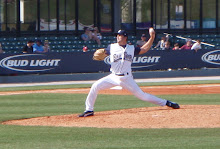
In my college playing career, I had the pleasure of pitching against Justin Verlander when he pitched for Old Dominion University and I was at the College of Williams & Mary. (Who, by the way, just won their second playoff football game and beat VCU in basketball....Go Tribe!) In our two starts against each other, I recorded a win, as did Verlander. Of course, he has gone on to become on of the best "hard throwing" starters in the Majors. I say "hard throwing" because it is very rare to find a pitcher such as Justin who can consistently pitch in the mid 90's and touch triple digits for a long period of time. (He has thrown that hard since college and just completed his5th big league season) Pitching for Detroit this season, Verlander went 19-9 with a 3.92 ERA. Even more impressively, he struck out 269 batters in 240 innings, both among the best in the American League. Most hard throwers "burn out" early in the season and eventually in their careers. I suppose it is still possible that Verlander will burn out, but for now he has shown an ability to maintain quality mechanics that keep his pitches sharp and velocity up. It is for these reasons, along with the personal connection that I've decided to look at Justin Verlander's mechanics in this week's Big Leaguer Breakdown.
Here's this week's video of Verlander pitching in extreme slo-mo to be looked at.
In the slo-mo video, it takes Verlander 24 seconds to get to the height of his leg lift. What you should notice is that his body weight does not shift very much from drop step, to piviot, to leg lift. The weight of his body is firmly planed on his right leg and you see very little body movement as his leg lifts to well above parallel. It requires a high amount of core strength as well as posture to maintain that body control without leaking forward.
His next movements are extremely important to notice. His leg drives straight down and Verlander almost immediately gets to his athletic position. In other words, the leg travels down before going forward with only a slight bend on the back leg. By not collapsing on the back leg, he is able to keep most of his body weight, and therefore, power in his hips and always stay taller throughout the delivery.
Verlander does tend to jump a bit to his landing. Watch the video from 27 seconds to 29 and you'll see what I mean. His foot looks as if it is about to plant and then he gains another few feet before planting. For many of my clients, this prevents them from getting on top of the ball and throw downhill. However, in this video, Verlander keeps his elbows "firing" upwards even during his 'jump.' You can tell he is getting over his front side by how bent his front knee is when it hits the ground. Although that knee does lock out on release, he is loose and flexible enough at the waist to still get over top and extend at release. Stop the video at th e31 second mark to see an absolutely perfect example of finishing over your front side with chest and chin to the target with an excellent glove turn down.
Rewatch the video from the 24 second to 31 mark and just watch his lover half. His timing is perfect with his hips leading the upperhalf to release. It is the speed of his elbows combined with the timing of his hips and height of his body at release that he is able to repeat his delivery and put serious velocity on the ball.
As always, rewatch this video and the second slo-mo video of him out of the stretch to really study his timing.
Please leave comments and/or questions......Until Next time!!

No comments:
Post a Comment